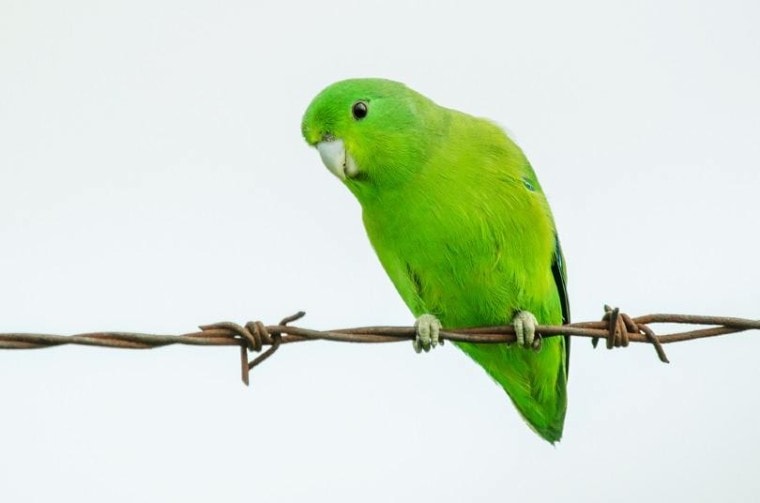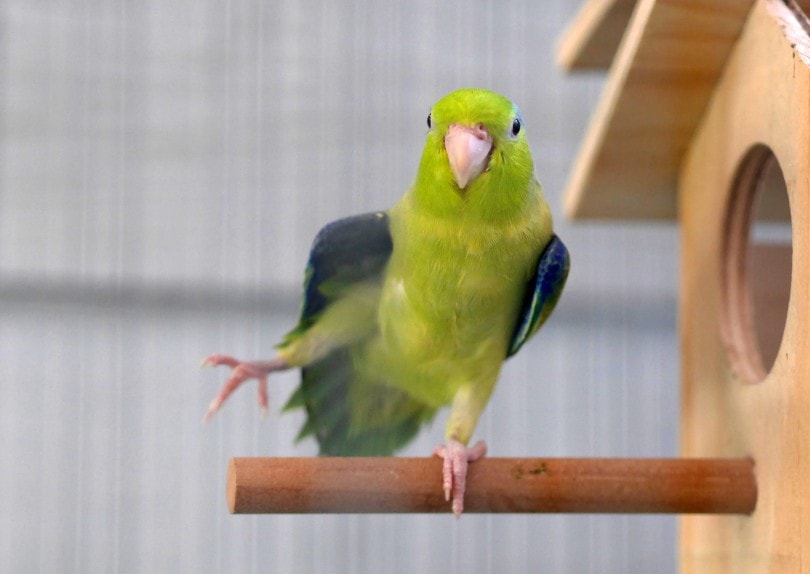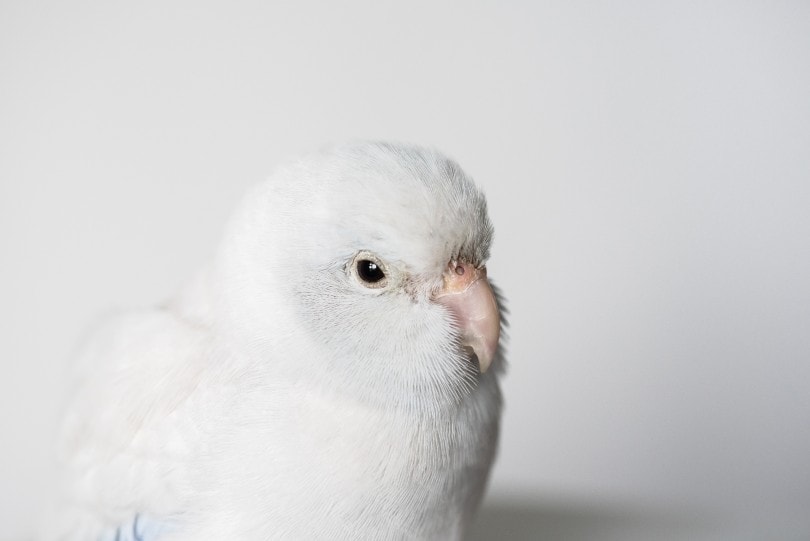
Parrot species may be known for their ability to vocalize and imitate words and phrases, but they cannot actually communicate with their owners. If you want to know what your parrotlet is thinking or how it is feeling, you should become familiar with your bird’s body language. If you take some time to understand your parrotlet’s behaviors, you will be more in tune with its mood and needs and be able to tell whether it is healthy and happy.
In this article, we will discuss some common parrotlet behaviors and what they mean.
 Common Parrotlet Body Language
Common Parrotlet Body Language
1. Beak Grinding
While the sound of your parrotlet grinding its teeth may seem to be concerning, there is usually nothing to worry about when birds do this. In fact, this behavior usually signals that your bird is content. Compare the grinding sound to a cat’s purring when they are pleased. You are most likely to hear this noise when your bird is getting ready to go to sleep, whether it’s right before a daytime nap or in the evening after its cage has been covered for the night.
2. Biting
As you probably can guess, biting is not usually a sign of positive emotions. Birds tend to bite when they are angry, scared, or when trying to defend their territory. If you find that your parrotlet is biting you, other members of your household, or any other pets you may have, you should spend some time observing your bird to see if there is anything in particular that is triggering the biting.

3. Chewing
Chewing is a natural behavior for birds in the wild and captivity alike. Birds tend to use chewing as a means to explore their surroundings. It’s also a great way for your pet to get some mental stimulation. If you find that your parrotlet is chewing things it shouldn’t, try buying some chewing toys for birds to see if that helps the behavior.
4. Dancing
Like humans, parrotlets like to dance—and they are good at it, too! Parrotlets and other parrot species are often excellent at picking up the beat to a song because they have a motor and auditory link in their brains. Try playing songs with different tempos to see if your bird’s dancing patterns change to match the beat of the music! As in humans, it’s a good sign when your parrotlet is dancing to some music because it usually means your bird is excited or happy.

5. Drooping
When a bird droops their wings, it can have many different meanings. For example, young birds might let their wings droop before they learn how to properly tuck them in. Drooping can also be a sign that your pet is tired. However, wing drooping may be a sign of illness in birds. If you notice that the drooping is happening frequently, talk to your vet to rule out any health problems.
6. Feather Preening
Birds need to preen their feathers regularly to keep them clean. Most birds have what’s known as a preen gland, or oil gland. In parrot species, the preen gland can be found right above the tail. Parrotlets use their beaks to distribute the oil from the preen gland to their feathers in order to keep them healthy. Birds are not very likely to groom if they are on high alert, so if you notice your bird preening, it probably means they are relaxed.

7. Head Bobbing
There are several reasons why your parrotlet may be bobbing its head. One of the most common explanations is that your bird is hungry. Birds bob their heads to beg for food when they are babies, so if your parrotlet is young, try offering them something to eat. Adults will also bob their heads, perhaps out of excitement, right before a meal.
However, when an older bird displays this behavior, they are most likely looking for attention. You might take this behavior to mean that your parrotlet wants to play.
8. Pupil Dilation
Unlike humans, parrotlets and other birds are able to control their pupils. The ability to shrink or enlarge the pupils on command is known as “pinning”. Birds do this when they are excited, scared, angry, or even when they are feeling aggressive. Use context to try and discern the reason why your parrotlet is pinning. Is it almost mealtime, and is their head also bobbing? Your pet is probably excited. Did you recently introduce another bird into your parrotlet’s enclosure? They may be feeling territorial.

9. Ruffled Feathers
Ruffled feathers are another behavioral clue that could mean many different things. For one, birds tend to ruffle their feathers while preening. If preening is the reason for your bird’s ruffled feathers, it will be pretty obvious. Your parrotlet may also ruffle their feathers as a way of relaxing, when they are cold, or when they are ill. If ruffled feathers are the only sign your parrotlet is experiencing, you probably don’t need to be too worried. However, if your parrotlet’s wings are also drooping, if they seem to be breathing hard without activity, or if you find them sitting on the bottom of their cage, it is time to take your bird to an avian vet.
10. Tail Wagging
You’ve heard of dogs wagging their tails, but did you know that birds also do this? As in dogs, a bird wagging their tail typically means that they are content.

11. Wing Flapping
If your bird is getting ready to fly, they will come as no surprise when they start flapping their wings. However, parrotlets will sometimes flap their wings without the intention of flying. Flapping while perched could be a sign of aggression or playfulness. It’s also possible that your parrotlet is simply showing off!
12. Vocalizations
Birds use many different kinds of vocalizations in the wild to communicate different types of messages. Let’s break down some of the different vocalizations you may hear from your parrotlet.
Chattering
If your parrotlet’s chattering is fairly soft and quiet, it could be a sign that your bird is content. If the chattering is fairly loud, you can assume that your parrotlet is trying to get your attention. Birds use chattering to connect with other birds in the wild, so you can assume that your parrotlet is trying to connect with you.
Clicking Tongue
If you hear your parrotlet clicking its tongue, they could be asking you to be picked up or petted. If you aren’t in the room but hear this noise, your bird is probably just trying to entertain themselves.
Growling
As you might expect, growling is a sign of aggression. Try to figure out what environmental factor might be triggering this response. Avoid handling or touching your parrotlet; they probably aren’t in the mood.
Whistling or Singing
If you hear your bird whistling or singing, you should take this as a good sign that your pet is healthy and happy. Like humans, birds sing when they are feeling good!

 Conclusion
Conclusion
Parrotlets are charismatic creatures that use many different behaviors or vocalizations to communicate. Sometimes it’s obvious what the behavior means, but sometimes interpreting your parrotlet’s actions requires careful observation and context clues. By taking the time to understand what your parrotlet is trying to say, you will be able to respond more efficiently with the care your bird requires, leading to a happier pet at the end of the day!
Related Read:
Featured Image Credit: Rafael Martos Martins, Shutterstock

 Common Parrotlet Body Language
Common Parrotlet Body Language





